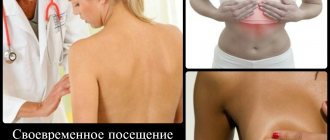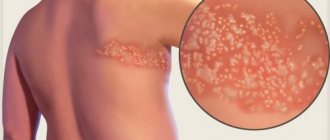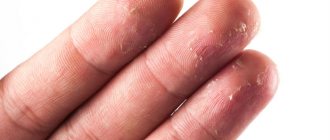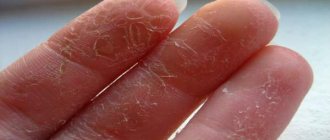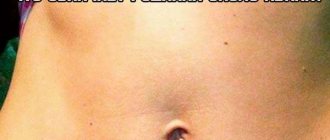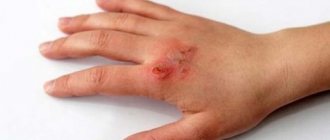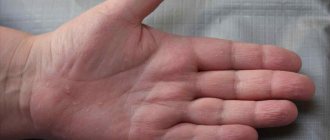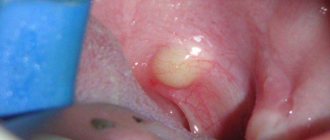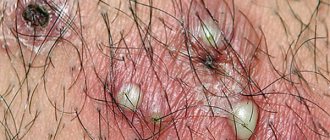There is a black dot under the skin. Home Remedies
At home, you can use sea or table salt.
You need to prepare a solution: take a couple of tablespoons of salt, stir them in a glass of hot water, then put the mixture on the fire and bring to a boil. After this, you need to moisten a cotton pad or a piece of bandage and apply it to the affected areas of the skin, waiting until the cotton wool/bandage has completely cooled and dried. There is no need to wash your face after the procedure. You can repeat up to 4 times a day. Aspirin can help fight rashes. You need to take one tablet and crush it very carefully. Then add a couple of drops of clean water. Gently rub the thick mixture into the pimples, being careful not to affect healthy areas of the skin. Wait a few seconds, then rinse thoroughly.
Lemon juice helps achieve a certain result. It must be diluted in clean water in a 1:1 ratio. The resulting solution should be used to wipe the rash areas. In addition, such a remedy can also be prophylactic, preventing the reappearance of subcutaneous pimples.
Some essential oils help relieve pain and inflammation, reduce the number and size of subcutaneous rashes. Tea tree oil is considered the most effective. However, it is important to remember that essential oils should be applied diluted to the skin. In addition, this product is not suitable for use by people who have additional injuries to the skin, are prone to allergies, or have overly sensitive skin.
In my youth, I believed that the appearance of acne, the so-called blackheads, was the privilege of teenagers with problem skin in adolescence. However, not so long ago I realized that in fact, acne (which is nothing more than pores clogged with dirt) can be present even on very good, smooth, almost perfectly even skin. Most often, they appear in the T-zone, where the pores are widest, and the reasons for their occurrence are different, but the most basic of them is banal skin pollution. Dirt, soot from cars, hot summer smog in the city, heat, as well as too heavy nourishing cream - all this can lead to excess sebum and severe contamination of the pores along the entire length. When clogged skin stops breathing, metabolic processes in it are disrupted, and acne, inflammation and other minor troubles may soon appear. However, clogged pores are not the only cause of blackheads; they can be completely different (hormonal, infectious), and today we will talk to you about how to keep your skin clean and effectively fight acne.
How to treat
The cause of the formation of pinpoint rashes on the fingers are both infections and pathologies of internal organs. Only a specialist can determine a treatment strategy after making a diagnosis.
Drug treatment
Black warts on the hands are treated with topical medications that include salicylic acid, potassium hydroxide, retinoic acid, phenol and fluorouracil. For the treatment of folliculitis and other infectious diseases, the following are used:
- antibiotics;
- antiviral drugs;
- antimycotics;
- keratolytics (exfoliating);
- immunostimulants.
Pigment dots indicate disturbances in the functioning of internal organs. Therefore, treatment consists of taking medications, the action of which is aimed at correcting their functions. Malignant tumors are treated with chemotherapy and immunostimulating agents.
Operation
Surgical intervention is indicated when drug therapy is ineffective, or the formation of benign or malignant tumors. To treat warts, they resort to radio wave surgery and freezing with liquid nitrogen. For melanoma, the tumors are completely excised, after which the patient is prescribed radiation therapy and alpha-interferon to prevent relapses. Moles are removed with a laser or electric needle.
ethnoscience
Alternative medicine cannot be used as the only treatment. They are used as an adjunct to medication. To combat warts, it is recommended to use:
- onion;
- celandine juice;
- spurge;
- spring buttercup;
- ordinary rowan.
To eliminate open comedones, use a local irritant. Ammonia or ammonia expands the skin pores, which helps the fat plugs to come out of them. To prepare a medicinal solution, you need to mix 1 tsp. products with 200 ml of boiled water. In addition, it is recommended to use milk-gelatin ointments and lemon juice.
A decoction of parsley and celandine discolors pigment spots, and infusions of calendula, chamomile and sage reduce the severity of inflammation in folliculitis. To restore the barrier function of the skin and prevent black spots on the skin, it is recommended to wash your hands with tar soap or rinse them with a decoction of St. John's wort.
Other methods
The success of treatment of dermatological diseases depends on careful personal hygiene.
Black spots on the skin of the hands are most often a sign of illness, a problem in the functioning of the body, so the best thing you can do is to seek help from a dermatologist.
The dog has a black dot under its skin. Black spots on a dog’s skin: photos, causes, treatment
The appearance of black spots on a dog’s skin is not dangerous, provided that their nature is associated with hormonal disorders. If changes in the body are accompanied by strange behavior of the animal, then there is a risk of developing internal diseases, which can manifest themselves in the form of spots on the body of a predominantly dark color. There is also the possibility of developing fungal infections and parasite activity, which can cause blackening of certain areas of the pet’s skin.
Safe options
The owner should not worry if he finds a black spot on his dog’s body that does not protrude above the surface of the skin, does not increase in size and does not bother the animal in any way. This may be normal skin pigmentation, which occurs mainly in adults and representatives of certain breeds. The reason for their appearance may be due to:
- hormonal imbalances in the body (pregnancy, childbirth, age);
- peculiarity of the breed (English and French bulldogs, pugs, sharpeis, dachshunds, etc.);
- permanent injuries in the places where they occur.
Important!
In most cases, age spots appear on the stomach and groin. The size ranges from a small coin to a large saucer.
Black spots on a dog's body photo
Possible diseases
The appearance of black spots on a dog’s skin does not always indicate physiological norms. There are a number of diseases that can provoke this symptom:
- Trichophytosis. Fungal infection of the skin, which manifests itself in the form of hair loss and darkening of the skin in this area. Itching is present, but not intense. They are most often infected from cats. The diagnosis is made only after microscopy of hair and scales from the lesions. The treatment is long-term (can last up to 2 months) with mandatory control bacterial cultures. Triderm can be prescribed externally or Rumicosis orally.
- Dermatitis. It has many forms and varieties. There is a predisposition of some breeds (English bulldogs often suffer from allergic dermatitis, and Shar-Peis from contact dermatitis). It can manifest itself as the appearance of red-black spots on the dog’s body that itch terribly. Due to constant scratching, there is no hair in this area and wounds appear. There is no treatment as such, because it is necessary to exclude the allergen that provokes the symptoms. If the animal has difficulty with the manifestations of dermatitis, then antihistamines and anti-inflammatory drugs can be prescribed.
- Pyoderma. A bacterial infection of the skin, which often occurs against the background of other diseases. It can be deep and superficial. The superficial form provokes the appearance of small rashes on the dog’s body, which dry out and scar over the course of the process. There may be no hair in this area and the skin may turn black. The deep form is accompanied by the appearance of large ulcers that scar and take a long time to heal. All this causes terrible discomfort to the pet, as the rashes are very itchy and painful. This disease is not transmitted to humans or other animals, so it is only dangerous for the sick dog. Diagnosis includes microsporia of scabs from the lesions. Based on tests and the severity of symptoms, a course of effective antibiotics is selected, which are combined with the use of special shampoos. Particular attention is paid to following all doctor’s recommendations and control bacterial culture after the disappearance of all symptoms. Pyoderma is a frequently recurrent disease that tends to be chronic.
- Demodecosis. It can also cause blackening of the dog’s skin in a particular area. At the initial stage, it appears in the form of small black rashes that may not be noticed under the fur. As the process progresses, the number of elements increases and there is a tendency to merge. The animal begins to comb out these papules if it can reach them with its paw (they often appear on the chin and under the tail). In place of scratching, large bald patches appear and the skin darkens. It is important to remember that demodicosis is not contagious and cannot be transmitted to other dogs or humans. Normally, every animal has this type of subcutaneous mites. Its activity can be provoked by serious internal diseases (liver, kidneys, heart) or long-term use of antibiotics. A special role in the treatment of demodicosis is played by qualified diagnostics, which will eliminate the possibility of confusing the subcutaneous mite with acne. To do this, a skin scraping is taken from the affected areas for microscopic examination. A chemical blood test may also be performed. The drug Ivermectin and its analogues enjoy good reviews. The duration of treatment depends on the severity of symptoms and can reach several months. An important condition for complete recovery is the complete absence of live or dead ticks in the control scraping.
I would like to finish with acne, which is often confused with demodicosis. They can also cause blackened areas of the skin in dogs of any age. Smooth-haired breeds are especially often affected. Acne in dogs is not dangerous unless it is complicated by pyoderma.
Alarming symptoms
Women with black spots that have arisen pay attention to the condition of the attributes; spots on the palms of various etiologies can become malignant. The following symptoms help to suspect the development of oncology:
- The growth did not increase in size in a short period of time.
- Inflammation with a hyperemic halo, pain, and swelling of the pathological area appeared around a small black dot.
- The surface of the woman's dark spot became rough.
- The boundaries of the formation on the palm have become fuzzy and blurred.
- Pathological contents in the form of blood, pus, and ichor are periodically released from the point.
- Child elements appeared around the mother formation.
- The growth on the woman’s palms begins to itch.
- The appearance of a painful infiltrate in the form of a dark dot is accompanied by high body temperature.
Having noticed one of the signs, a woman needs to be examined by a dermatologist or oncologist. Doctors will determine the cause of the change in formation, and in the early stages it will be possible to stop the progression of the unfavorable condition.
Causes of age spots on the hands after 40 years and 50 years
Pigmentation on the hands appears due to the uneven distribution of melanin pigment in skin cells, its excessive (or insufficient) synthesis. Spots can form in people of any gender and age. After 40 years, marks are often one of the signs of natural aging.
The body's regeneration and metabolism processes slow down, the production of its own collagen and elastin decreases, and the condition of the skin worsens. Particularly affected are areas of the body that, for the most part, are not protected by clothing and are more exposed to the negative effects of the environment than others.
The appearance of dark spots in both women and men over 50 years of age is considered normal. However, there are a number of factors that contribute to the intensive formation of marks.
The main causes of pigmentation disorders on the hands:
- genetic predisposition;
- endocrine diseases;
- smoking;
- hormonal imbalance (for example, during menopause);
- kidney or liver pathologies;
- prolonged exposure to ultraviolet radiation. Age spots are common among bronze tanners;
- avitaminosis;
- injury to the integument;
- diseases of the cardiovascular system;
- use of low-quality creams;
- constant hypothermia;
- a course of taking certain medications (such as retinoids, tetracycline antibiotics, and others);
- gastrointestinal disorders;
- constant contact with harmful chemicals without personal protective equipment.
Pigment spots themselves are not a disease, but can be a sign of certain disorders in the body.
Types of calluses and treatment methods
Gvozdevaya
A rare type of callus.
Does not have a hole or black spot in the middle.
Outwardly it resembles a nail, the head of which is on top.
It has a small round shape.
Rod
A distinctive feature of this callus is its structure.
The surface of the skin acquires a slight compaction, and under it there is a base.
The main inconvenience is severe pain due to the root located in the tissues.
Such a deep callus can be removed by contacting a medical center for hardware or surgical intervention.
There are several ways to get rid of a callus, for example drilling.
Cryotherapy, as a result of which the callus is frozen, and it dies off on its own.
Laser action that evaporates the liquid contained in the callus, which leads to drying of the rod and the formation itself.
Water
A similar callus can be observed when wearing uncomfortable shoes.
A blister appears that is filled with blood or lymph fluid. The outer skin is thin and easily torn from external influences.
A watery callus should not be pierced or picked off on its own. The treatment procedure is aimed at eliminating mechanical effects at the site of injury.
As a result, the neoplasm will heal on its own, and the contained lymphatic fluid will dissolve and help restore the skin.
Dry
Occurs in various parts of the body. It is a small keratinized part of the skin. It feels hard and unpleasant to the touch.
Treatment should be carried out even in the absence of painful symptoms.
To do this, steam your feet in warm water with various additives such as soda, soap, potassium permanganate or tea tree oil.
Corns
This callus is similar to the one described above.
However, it only appears on the soles of the feet.
It has no definite boundary and varies in size.
The cause of the appearance is general dry skin, frequent walking and wearing hard shoes.
Cone
It appears as thickenings on the big toes. Sometimes it causes discomfort when walking.
The cause may be heredity.
Development occurs for no apparent reason.
Bumps also occur when wearing uncomfortable shoes for a long time.
If the callus is exposed to regular mechanical stress, it can turn into a bunion. This type of callus occurs on the big toes near the joints and contains fluid inside.
The result is severe pain when walking.
Treatment for a bump or bunion should begin by changing your shoes to more comfortable ones. If the callus does not cause pain and does not grow, then there is no reason to worry. But when it becomes a hindrance, you should visit a surgeon.
Outdated
Without timely action, the rubbed parts of the skin turn from new calluses into old ones, the skin on which is keratinized. Such formations are most uncomfortable on the toes. The treatment is long and difficult. Modern pharmacology provides many means to get rid of rough skin. Their action is based on softening and then removing the growth.
The most well-known method for removing calluses on the feet is cutting. To do this, you need the following: a bath with hot water, soap and soda.
- Keep your feet in it for 15 minutes.
- As a result, the old skin will become softer and the top layer can be removed.
- Then apply a patch or lubricate the area with salicylic acid.
The procedure is carried out carefully. The drug should be kept away from healthy skin to avoid damage.
Root
Black or black-spotted callus. This formation indicates the location of the root under the skin. The blackhead has a round, keratinized surface. The cause may be fungal diseases or unsuitable shoes. When a black dot is clearly visible on the callus, you should turn to laser treatment or cryotherapy.
Moles
Black dots that appear on the hands can be ordinary moles. A nevus may initially be black in color, and such moles themselves are not considered malignant. However, if a previously lighter mole begins to darken and even increase in size, then don’t even think about folk remedies and rush to a dermatologist.
A change in the color, shape and size of any mole is an unfavorable sign, most likely indicating the development of skin cancer - melanoma.
Warts
Black warts are often colored this way due to blood clots that accumulate in the vessels of the growth. They tend to appear on the hands and bodies of old people, and also acquire a dark color over a long period of time, usually several years, on the skin.
The appearance of black warts at a younger age should alert you, and in such cases, be sure to see a doctor. By their nature, warts are benign growths on the skin, but not a single doctor excludes the possibility of their degeneration into a cancerous tumor.
Black warts are treated in a clinic using the following methods:
- laser;
- electric needle;
- liquid nitrogen;
- radio waves.
The doctor may prescribe any drug for topical use if he considers this a sufficient method of therapy. You can read about the treatment of warts using traditional methods on our website. But in any case, before using home remedies, visit a dermatologist first.
Prevention
Following these recommendations will help prevent the appearance of blackheads on the skin:
- observe the rules of hygiene;
- regularly use scrubs and cleansers;
- avoid stress;
- treat gastrointestinal diseases in a timely manner;
- normalize your diet, consume enough fiber;
- protect your skin from ultraviolet radiation;
- take medications to maintain immunity;
- wear clothes made from natural fabrics.
Cosmetology procedures
You can quickly and effectively remove age spots on your hands in a beauty salon. Cosmetologists do this in several ways.
Here are the most popular of them:
- Laser whitening is recognized as a safe, low-traumatic method of therapy. The beam specifically “burns out” the pigmented layer of the epidermis, and healthy skin of an even shade is formed in its place. Neighboring tissues are not damaged. Several sessions are required to achieve a lasting result, but after the first the marks become significantly lighter;
- Chemical peeling involves exfoliating the surface using a special acid-based composition. The procedures vary in depth of impact. With the help of deep peeling, even dark old spots can be eliminated, but its use is permissible only for medical reasons. This method is not suitable for people with sensitive skin;
- cryotherapy is a procedure for “freezing out” the problematic epidermis with liquid nitrogen. Under the influence of ultra-low temperatures, the top layer of integument dies and is renewed. The disadvantages of the procedure are the duration of the course, complications are possible in the form of loss of sensitivity of the treated area;
- ELOS is a type of laser therapy. At the first stage of manipulation, the deep layers of the dermis are exposed to infrared radiation, which increases the sensitivity of the fibers. On the second - a laser that destroys melanin;
- dermabrasion - grinding of hands with a special device with a rotating head. The skin is pre-treated with an abrasive compound. The procedure stimulates the synthesis of your own collagen, restoration processes are accelerated, pigment does not accumulate, and complexion is evened out.
We suggest you read How to get rid of cracks on your fingers and nails forever
Attention: all therapeutic measures must be carried out by a qualified cosmetologist in a specialized medical institution. Incorrect selection of substances or device settings can cause serious injury.
When pigmentation is provoked by diseases of internal organs or metabolic disorders, the use of pharmaceutical drugs is required.
